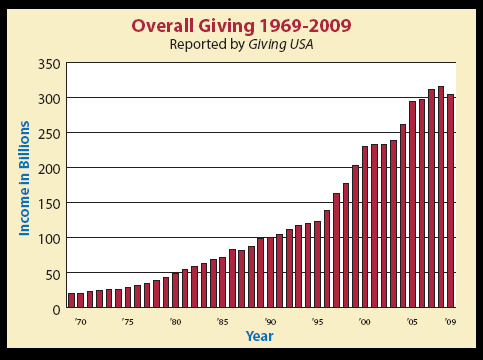Several recently released reports are shedding light on charitable giving in 2009. A number of these studies are based on surveys of actual gifts to various charitable organizations and institutions, while others use econometric models to estimate giving based on analysis of various sets of data. Because these studies use such different methodologies, as might be expected they do not always come to the same conclusion about the state of charitable giving in America. The reports for 2009 are no exception.
Results of surveys
In February of 2010, the Council for Aid to Education (CAE), a subsidiary of The Rand Corporation, released the results of its survey of charitable giving to higher education. The findings reveal that giving to higher education dropped by over 12% in the fiscal year that ended June 30, 2009, which is the largest drop in the survey’s 50-year history. The survey further reveals that giving to higher education by individuals fell by nearly 18%.
The Association of Healthcare Philanthropy (AHP) has reported that giving to healthcare in the calendar year 2009 (85% of which comes from individuals) fell by 11% from 2008. Additionally, a study released by Target Analytics shows that gifts under $5,000 by 38 million donors to 79 of the nation’s largest mass-based organizations declined by a median of 4.8% in 2009, with half reporting declines greater than that amount.
The Chronicle of Philanthropy reports that even among the nation’s 400 most successful fundraisers, a group known as The Chronicle’s Philanthropy 400, giving in 2009 declined 10%. The Chronicle has also announced a decline of 64% in the amount of gifts of $1 million or more last year.
Predictive models
In contrast to results of surveys of gifts received, predictive models base their estimates on analysis of economic and demographic data. Perhaps the most widely cited predictive modeling effort is the Giving USA report, which is prepared by the Indiana University Center on Philanthropy and released each June. While often misinterpreted by the press as a definitive pronouncement on giving in America, the Giving USA report is intended to be only a preliminary estimate of giving for a particular year.
Based on analysis of general economic trends such as gross domestic product and personal income, factors that have proven to correlate to a large extent with trends in giving in past years, the Giving USA model does not attempt to take into account the national mood, consumer sentiment, unemployment rates, or other factors that may have influenced charitable giving in the year for which predictions are being made. The model has also never been tested in the midst of an economic downturn as severe as the one Americans are currently experiencing.
These limitations may help explain why Giving USA estimates for giving in 2009 differ significantly from the survey results announced by CAE and others.
The recently released Giving USA report for 2009 estimates that charitable giving in America last year reached $303.75 billion, a decline of 3.6% from adjusted 2008 levels. The initial account for 2008 also revealed a decline from 2007 numbers, but a revision of 2008 figures based on subsequently released IRS data now indicates that Americans surprisingly gave more in 2008 than in 2007.

That was due to a significant increase in bequests in 2008 driven by a handful of exceptionally large gifts via estates. Bequests returned to a more normal level in 2009, but still were up slightly over 2007. The Chronicle of Philanthropy also reported a surge in large bequests in 2008. Seven of the top ten gifts in 2008 came in the form of bequests. By contrast, there were no bequests listed among the top ten gifts in 2007. The sharp increase in bequests in 2008 mirrors charitable giving during the Great Depression, when bequests accounted for a higher percentage of charitable giving and helped many institutions weather the economic storm. See the March 2009 issue of Give & Take for more information on bequests in recessionary times.

Remarkably, Giving USA reports that giving by living individuals in 2009 ($227.41 billion) declined by just 0.4% when compared to 2008 figures ($228.23 billion) and was essentially flat when adjusted for inflation. These numbers contrast sharply with CAE and other survey results referenced above, which reveal a much larger drop in individual giving.
While Giving USA is perhaps the most widely cited predictive model for charitable giving, another recently released predictive model prepared by Paul Schervish and John Havens of The Boston College Center on Wealth and Philanthropy estimates that overall giving in 2009 fell by roughly 5%. Unlike Giving USA, the CWP study takes unemployment rates into account when estimating giving.
IRS numbers for itemized gifts in 2008 will be released later this summer and should shed further light on the actual level of giving in 2008. Just as IRS reports for estate gifts resulted in an upward revision by Giving USA for 2008, future data could lead to an upward (or downward) revision for 2009.
To learn more about the Giving USA report, see the Giving USA Foundation’s Web site at www.aafrc.org. For more information from The Chronicle of Philanthropy, visit www.philanthropy.com.
Details about the Council for the Aid to Education’s report may be found at www.cae.org.

